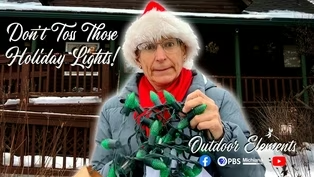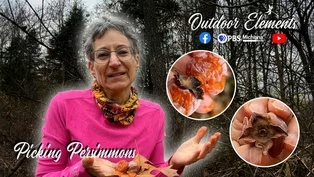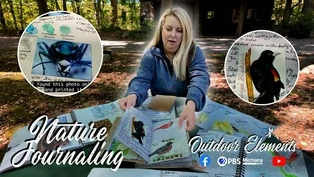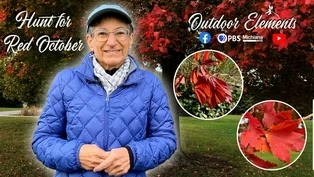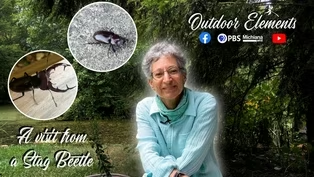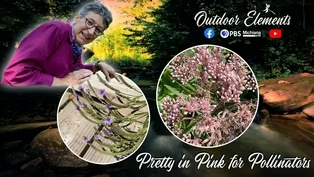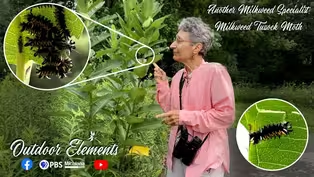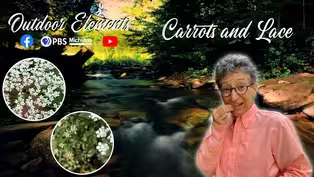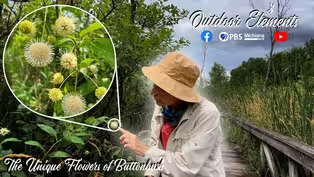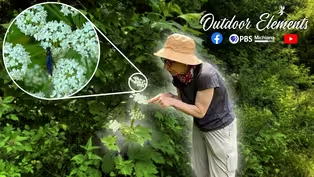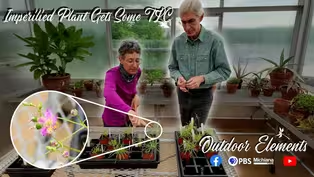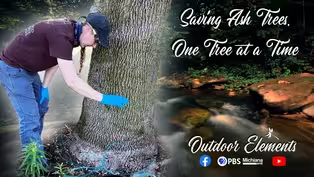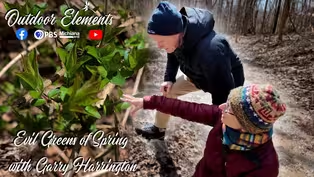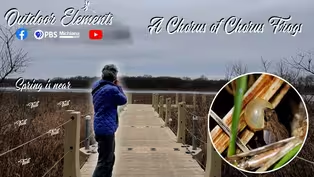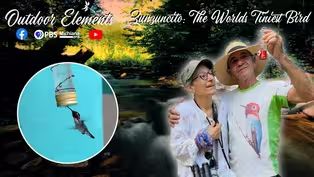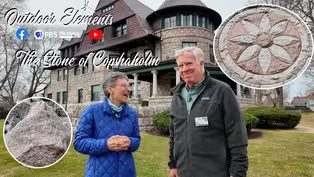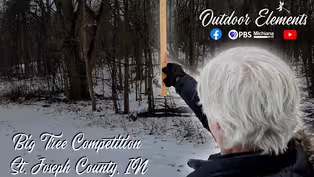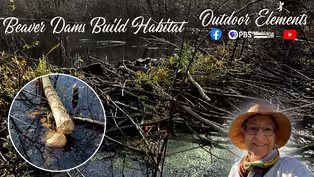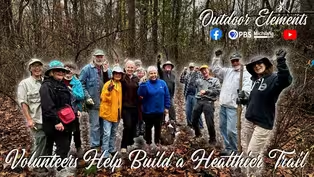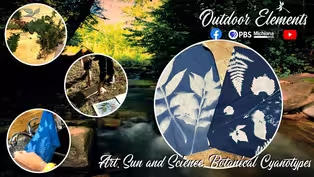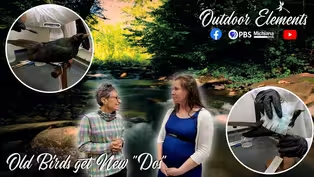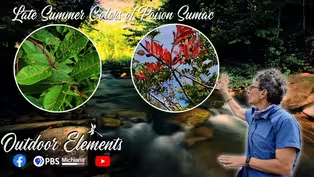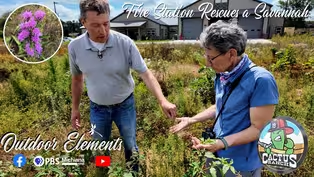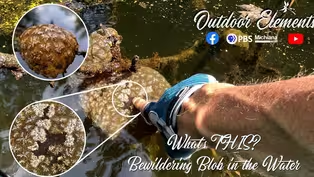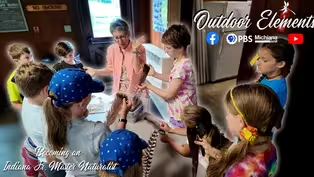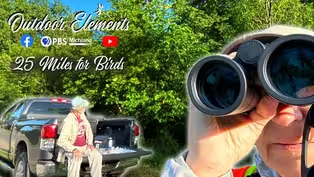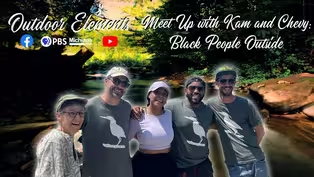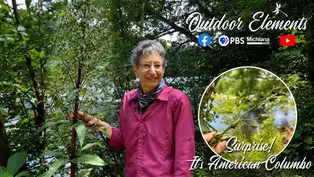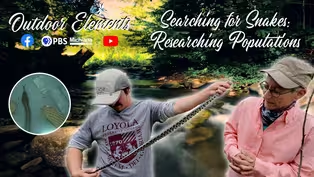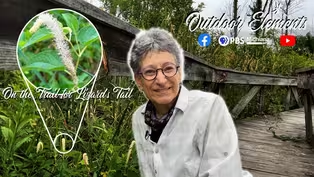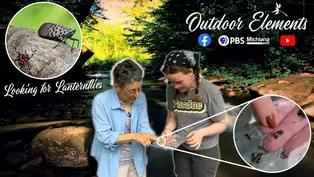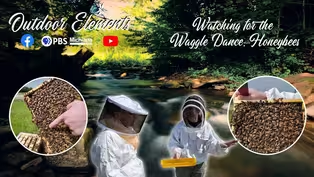Outdoor Elements
Elkhart's Rivers Converge Here
Clip | 9m 58sVideo has Closed Captions
Evie is joined by Jamison Czarnecki to explain the history of the park and what the two ri
Rivers are an important part of a cities recreation and at Island Park in Elkhart there is a convergance of two rivers. Evie is joined by Jamison Czarnecki to explain the history of the park and what the two rivers have meant to downtown Elkhart over the years including the recreation.
Problems playing video? | Closed Captioning Feedback
Problems playing video? | Closed Captioning Feedback
Outdoor Elements is a local public television program presented by PBS Michiana
Outdoor Elements
Elkhart's Rivers Converge Here
Clip | 9m 58sVideo has Closed Captions
Rivers are an important part of a cities recreation and at Island Park in Elkhart there is a convergance of two rivers. Evie is joined by Jamison Czarnecki to explain the history of the park and what the two rivers have meant to downtown Elkhart over the years including the recreation.
Problems playing video? | Closed Captioning Feedback
How to Watch Outdoor Elements
Outdoor Elements is available to stream on pbs.org and the free PBS App, available on iPhone, Apple TV, Android TV, Android smartphones, Amazon Fire TV, Amazon Fire Tablet, Roku, Samsung Smart TV, and Vizio.
Providing Support for PBS.org
Learn Moreabout PBS online sponsorshipCity parks right in your own backyard often have interesting history and natural connections often to water.
We're going to talk a little bit about the importance of rivers and the role that they can play in City Recreation.
And we are with Jamison.
So Nike and you are the superintendent of this Elkhart City Parks Department.
So thanks for being here today.
This is a lovely, quiet, shady spot.
Yes.
And tell us where we are so right now, we're currently in between Lundquist Bicentennial Park and the beginning of Highland Park on the old wooden bridge.
And so basically, once we cross this, we will be on an island.
And that's how Island Park got its name.
But how long has it been a park?
Yeah.
So it's been a Parsons.
1887, the Beardsley is, who helped found Elkhart where the ones who donated the property and and it's taken a variety of different amenities to the time.
But it's been a park that long and it's it's been a joy for everybody Great recreation site for people bicycling, walking, playground, whatever.
But I'm especially interested in the fact that it's obviously being an island surrounded by rivers.
So how about if we walk over the bridge, get over onto the island, and then I want to talk about the rivers that are here.
Sure.
Okay.
Let's go We've been hiking the path here on Island Park, and as we're headed towards the River Edge, this shelter is gorgeous.
Tell me about the history.
So this is the old picnic shelter.
It was built in the originally the 1930s by the Works Progress Administration.
Through the Roosevelt administration.
And so they redesigned and you can still see that their original brickwork today, their stonework.
And so they did that and they didn't artesian well that they turned into a drinking van at the same time.
And so this was yeah this was originally in the center of the property and then in the 1930s 1940s they got brought over to here and rebuilt and so it was kind of expanded upon as the picnic shelter and so that's when they did that and it has been a wonderful addition to this park and loved by many people.
Yeah, it is really special.
So let's keep walking because the river's right here behind us and it's on the other side of the island here.
So let's loop around because I want to see where two rivers come together and there's a special name for that.
So we're going to check that out.
Let's go this this the artesian well and you were talking about.
Yeah, yeah.
This is that's amazing.
So it just runs continuously, huh?
Yeah.
So artesian wells are formed underground.
It's it's a well, that's between two groundwater surfaces.
It's used by pressure.
And so it's different from a hand well, a hand dug well.
Yeah.
And so this will allows the pressure to come up and spin through.
And so it's been operating ever since it was an artesian spring way back when, almost a hundred years ago.
And when the WPA built the pavilion and turned into this at the same time, they decided to just make it a drinking fountain provide endless water for people.
And it's still used today, and many people enjoy it.
That's great.
You know, I love seeing all the old stuff like this that's still preserved.
Is that people can still use, which is great.
And of course, right behind us is the same Steel River.
So let's go and take a look because this is a really pretty stretch.
Sure.
Yeah.
I can see, you know, there's nice ripples here.
Mm hmm.
And I'm looking over here, Jamison.
So that bridge beyond that takes you off the island.
The next fully connects to another park, doesn't it?
Yeah, it's called Hyde Park.
And so that bridge was sponsored a lot by Miles Laboratories back in the day.
And so when that was funded, it created that opportunity for people to go from one course bar to island to high dove.
And then you can continue on and head up to to Walker Parks.
There's a nice, really nice string, a nice string of green space.
Now, the river here, this behind us with all the riffles is the St Joseph.
Yes, right.
And so the St Joseph River splits around Ireland Park.
Yeah.
Where does the St Joseph River start?
St Joe River starts in Hillsdale, Michigan, actually, and runs through about 210 miles, but stops through here in Elkhart, the South Bend.
And it's fun because the St Joseph River actually spends quite a bit of time in Michigan.
Right.
And then kind of dips down here into Indiana and then goes back up into Michigan.
Right.
So, so it spend some time here creating essentially Highland Park.
I have heard that this island at one time is what gave Elkhart its name.
Is that true?
Yeah.
And so in the mid 1800s, when the Beardsley family purchased the land from the Pottawattamie native tribe, they they were told that this island was in the shape of the heart of an elk.
And I think back then it looked more like the heart of an elk.
But whatever that looks like, I don't know.
Right.
Since that time, erosion and everything has made it more of a the oval shape that we see today.
But they took that name from here and kept it for the whole city.
And now we're the city with the heart.
Nice, right?
I mean, I think it's really cool.
That a park actually is the reason our city got its name.
Right, right to the heart of downtown, right?
Is.
Yeah, it's just all.
Well, weird place.
Yeah, it is.
And of course, you know, I just got to mention right here behind us, beautiful sycamore.
Sycamore is down here the second in Cottonwood, which are typically found along rivers.
Yes.
Yeah, yeah.
Great, beautiful, beautiful trees here.
All right.
So we're going to make our way around because two rivers come together down here, right?
All right, let's go look one of the things I love about this little spot, which is right in the middle of the city, is it's great for birds.
Like there's tons of swallows here.
Beautiful osprey fishing here in the St Joseph River.
There's Mallard Ducks course there's Canada geese, but it's actually a pretty birdy.
Little park for for its size.
Right.
Which is wonderful.
But there are many other things that people can do here.
For instance, tell me about this Kayak launch over here on that.
So these were recently installed this year.
And so there's two that we're put in and we have one here, Beardsley Park.
And then it goes you can go west and just put it into the Saint Joe here and continue down.
And right across from McNutt, there's a park called Edgewater Park and you can get out there.
And so it's our the first county is kind of ADA accessible kayak route and so we're hoping to program that.
It's a great detail, but we've already seen a lot of people utilizing it from all backgrounds and ages and great a lot of people will put in on the Elkhart and come down and get out here or they'll put in here and head down west.
So you just mentioned people will put in at the Elkhart right show right here is basically where the rivers come together, right?
Yes.
And that where rivers come together like that.
What's that called?
It's called a confluence.
A confluence.
So this is kind of a historic natural site because two rivers coming together, the Elkhart River coming in here and the St Joseph River coming in here.
So the water is essentially mix and onward they go out to Lake Michigan, right?
Yep.
Which is really cool.
So this is the spot essentially where the Elkhart is coming in, right?
Yeah.
And that's interesting because I if I may, this is what's been so interesting about Elkhart as a city and why parks like these are so interesting because they've got so much rich cultural history.
There's also a lot of natural history but cultural with why Elkhart was developed, where it was and how it's been successful as a manufacturing city and how that's really shaped today, which is a good thing to remember for so many years.
Cities turned their back against the river, right?
They put all their factories in their mills and then people couldn't access the river.
And of course, we dumped lots of bad stuff in the river, out of sight, out of mind.
Right.
But obviously, the tide has turned.
I guess that's a saltwater metaphor.
Maybe we shouldn't use that.
This is fresh water but now cities are really doing great jobs, just like this park of opening up the river access to people.
Right.
Why is that important?
Oh, so many reasons.
And I love where we're at today because you look at the history of the Elk River in the St Joe River and around 1950 before the Clean Water Act, you know, they were doing testing and they found two fish species there in the river at that time just too.
And today we have an aquatic biologist who does amazing work and they've been doing this amazing work for three decades almost now.
And we know that the rivers are getting cleaner and cleaner, and that's been because of the Clean Water Act and many other things that are still happening today.
We're removing CSOs.
And so we've changed the dynamic of the river and people are just now starting to realize that the rivers are not these nasty corridors of waste.
They're beautiful wildlife refuges that people can enjoy and interact with.
And that's why we're doing more work with the waterways now and, and getting people to understand that they're not the same rivers they used to be.
And that's huge for for people's mental health and their recreation they're healthier and it becomes a more livable, healthy community for people.
And that's exactly right.
So as you know, people who think about cities and making them viable and livable and walkable shore rivers can play a really important part, especially when you have a beautiful spot like Island Park.
It's a great space.
Yes, absolutely.
Thanks so much for sharing this beautiful spot.
I hope people will come and visit the Elkhart Parks because there are little gems, I think.
Right, right.
In town remember, you can find your own outdoor elements when you visit area parks in natural areas.
Thanks so much.
Don't Toss Those Holiday Lights! | OE
Video has Closed Captions
Clip | 8m 25s | 🎄✨ Got holiday lights that no longer sparkle? Don’t toss them! ♻️ In this ep (8m 25s)
Video has Closed Captions
Clip | 3m 38s | 🍂✨ Out on a fall walk in the woods, Evie stumbled upon a sweet seasonal surprise — (3m 38s)
Urban Transformation at Milkweed Gardens
Video has Closed Captions
Clip | 17m 11s | No description (17m 11s)
Video has Closed Captions
Clip | 11m 50s | 🌿🖊️ It’s time to slow down and connect with nature! In this episode of Outdoor E (11m 50s)
Video has Closed Captions
Clip | 3m 20s | 🐔👀 There’s a possum in the hen house! 🐾 On this episode of Outdoor Elements, E (3m 20s)
Video has Closed Captions
Clip | 2m 57s | 🍁 It’s that time of year when nature puts on its most colorful show! 🌳 In this epi (2m 57s)
Video has Closed Captions
Clip | 3m 36s | 🌿🪲One of our awesome viewers spotted a beetle making its way across the driveway and (3m 36s)
Video has Closed Captions
Clip | 3m 24s | A viewer shared a fascinating video of a Paintedhand Mudbug, and Evie dives into the detai (3m 24s)
Pretty in Pink for Pollinators
Video has Closed Captions
Clip | 5m 3s | At Lydick Bog Nature Preserve, Evie spots a burst of pink in a wetland. She explores these (5m 3s)
Another Milkweed Specialist: Milkweed Tussock Moth
Video has Closed Captions
Clip | 4m 36s | No description (4m 36s)
Video has Closed Captions
Clip | 3m 43s | Evie spotted Pointed-leaf Tick-Trefoil and shares how to identify this plant. (3m 43s)
The Unique Flowers of Buttonbush
Video has Closed Captions
Clip | 3m 58s | Evie finds Buttonbush at Spicer Lake Nature Preserve (3m 58s)
Saving Ash Trees, One Tree at a Time
Video has Closed Captions
Clip | 11m 16s | No description (11m 16s)
Bringing Bees Back to the Nature Center
Video has Closed Captions
Clip | 6m 10s | No description (6m 10s)
Gathering for Science: An Environmental Research Symposium
Clip | 10m 27s | Evie stops by the St. Joseph County Public Library during their Earth Day celebration to c (10m 27s)
Surprising Color in the Woods: Blue Stain Fungi
Video has Closed Captions
Clip | 3m 48s | No description (3m 48s)
Maple Sweet Treat for Ants | Outdoor Elements
Video has Closed Captions
Clip | 1m 34s | A sweet surprise in the woods! (1m 34s)
Evil Greens of Spring with Garry Harrington
Video has Closed Captions
Clip | 12m 56s | Things are greening up in the spring woods, but it’s not necessarily a welcome sight. (12m 56s)
Volunteers Help Build a Healthier Trail
Clip | 6m 9s | At Lydick Bog Nature Preserve, volunteers make a big difference in protecting and maintain (6m 9s)
Art, Sun and Science: Botanical Cyanotypes
Clip | 6m 49s | Experimenting with cyanotype fabric brings nature to life in beautiful, sun-printed design (6m 49s)
Clip | 3m 57s | Evie shares a fun and simple craft idea using autumn leaves that the whole family can enjo (3m 57s)
Late Summer Colors of Poison Sumac
Clip | 1m 59s | Watch out for this colorful danger at Lydick Bog Nature Preserve! (1m 59s)
What's THIS? Bewildering Blob in the Water
Clip | 5m 8s | What’s that mysterious blob in the water (5m 8s)
Clip | 7m 14s | Find out how thousands of volunteers help the US Geological Survey teams and other resourc (7m 14s)
Meet Up with Kam and Chevy: Black People Outside
Clip | 5m 18s | Meet the inspiring creators behind Black People Outside. (5m 18s)
Surprise! It's American Columbo
Clip | 5m 14s | Explore the unique features of the American Columbo. Discover its habitat, appearance, and (5m 14s)
Searching for Snakes: Researching Populations
Clip | 13m | Delve into the world of snake population research in northern Indiana and discover the met (13m)
On the Trail for Lizard's Tail
Clip | 3m 10s | We are at @SpicerLakeNaturePreserve to learn about the fascinating plant known as Lizard's (3m 10s)
Clip | 7m 35s | Uncover the impact of the invasive Spotted Lanternfly. (7m 35s)
Clip | 3m 6s | Love it or hate it, that flying white fluff looks like “Snow in June!” (3m 6s)
Watching for the Waggle Dance: Honeybees
Clip | 12m 32s | Join Evie as she interviews Morgan Carr-Markell, Assistant Professor at Saint Mary's Colle (12m 32s)
Providing Support for PBS.org
Learn Moreabout PBS online sponsorshipSupport for PBS provided by:
Outdoor Elements is a local public television program presented by PBS Michiana
